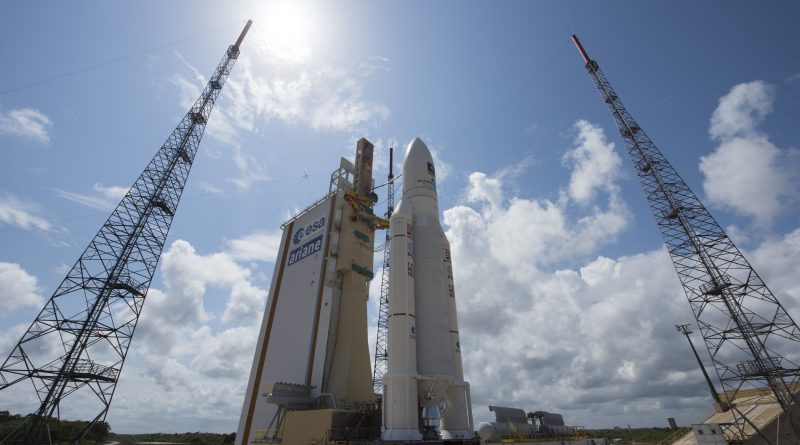Operations Resume at Europe’s Guiana Space Center after Month-Long Stand Still
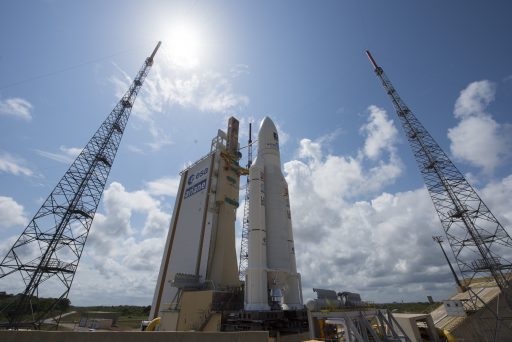
The Guiana Space Center returned to operations on Monday after protests and a general strike brought French Guiana to a halt for over a month, interrupting work a the European-run spaceport and as a result delaying three missions out of the equatorial launch base.
Europe’s Ariane 5 rocket stood ready with two satellites under its payload fairing when the social movement began on March 20, holding up the rocket’s rollout to the ELA-3 launch pad. Initially, Arianespace anticipated the situation would resolve by the end of the week and pushed the launch on a day-by-day basis, but it soon became clear that the entire operation at Europe’s spaceport would grind to a hold for an extended period.
Twice before have labor disputes caused launches out of French Guiana to suffer delays – the V29 launch of an Ariane 44LP with a pair of satellites slipped four days back in 1989 because the contractor for the range radar went on strike and VA204 in September 2011 had to be pushed by one day because Telespazio, in charge of telemetry distribution, went on strike. The 2017 dispute would eclipse both previous events, bring the entire launch base to a still stand and cause a satellite to be flown back to Europe.
To recap, #CSG still blocked,roll-out might happen due to Endel ending strike(TBC) #VA236 & #VS17(due to range reconfig) launch dates TBC pic.twitter.com/Nr4oMx8KOu
— DutchSpace (@DutchSpace) March 23, 2017
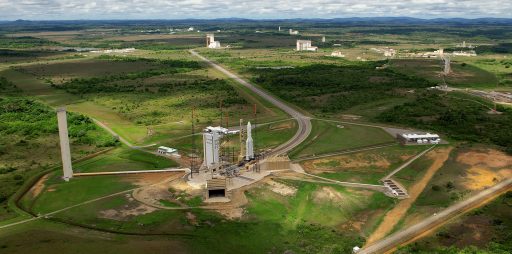
The launch of VA236 was initially delayed by a strike of Endel workers, responsible for transporting the Ariane 5 rocket from the Final Assembly Building to the launch pad. Negotiations with Endel workers resolved the issue within a few days, but a wider demonstration eventually ended in a general strike across the small French territory.
Protestors raised a wide range of concerns including high crime rates, poor educational opportunities in the rural regions of French Guiana, aging infrastructure as well as the imminent privatization of a hospital. Road blocks were established around large cities in French Guiana including the access road to the space center which became one of the more prominent bargaining chips of the protest movement.
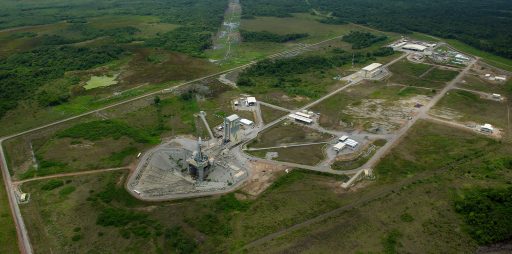
Protest leaders demanded over €3 billion to improve conditions in French Guiana – an overseas department with the same political standing and legal rights as the rest of France.
By March 23, flights into French Guiana from France were turned around because work at Cayenne airport had been stopped. Officials who had arrived to watch the launch were flown out from a hotel near the space base via helicopter and took a Transall military plane to Cayenne airport where they were able to depart on one of the last outgoing flights. The satellite engineering teams remained in place in the hopes of getting into a launch posture shortly after the disputes were settled.
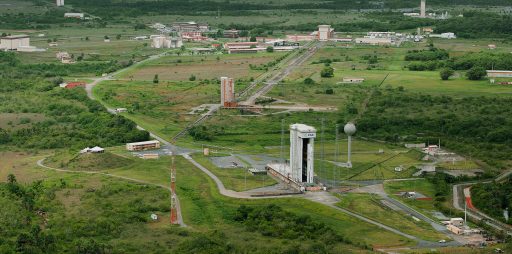
Large gatherings and public debates were held in the entrance to the Guiana Space Center and some attempted to enter the center which is under permanent protection by a detachment of the French Foreign Legion. Long lines formed at gas stations when road blocks were temporarily lifted over the weekends, but despite French ministers and former CSG officials flying in to negotiate, no progress was made over the first week of April.
The next victim of the labor dispute was Eutelsat 172B, booked for a ride on the next Ariane 5 originally set for launch on June 1st. The satellite arrived aboard an Antonov cargo aircraft in late March and spent close to one week on the ground at Felix-Eboue airport where no one was working to offload the S/C container, let alone transport it to the spaceport. The Antonov was eventually sent back to Toulouse, France to ensure the satellite would remain in a controlled environment at all times.

A detachment of 300 engineers, technicians and support personnel from Russia tasked with operating the Soyuz launcher from the Guiana Space Center left French Guiana after four weeks of stand-still, eliminating the possibility of returning Soyuz to service immediately after the strike ended.
By mid-April, a counter movement formed to protest the road barricades and some blocks were lifted, but the blockade of the space center continued while negotiations with the French government continued through different channels. Government representatives and local activists came to an agreement on Friday for an immediate investment of €1.1 billion to improve public safety, health care, education and transportation with another 2.1-billion funding package being placed under priority review by the French government.
With the accord signed on Friday, Arianespace decided to return the launch base to full operations on Monday. The five-week stand down at the base may have cost the company as much as €10 million according to company officials estimating the impact of the strike on Arianespace and the various partners involved at the CSG.
Arianespace reaffirmed the company would still be able to fly out its planned 2017 manifest of a dozen launches, making up for lost time by taking advantage of a planned lull in activity in May and June for the three campaigns that were affected by the strike.
First up will be Ariane 5 VA236 with the SGDC and Koreasat-7 satellites that is now targeting a May 4 liftoff after being kept safe inside the Final Assembly Building throughout the month-long stand-still. Both satellites were kept in place atop the launch vehicle in stand-by mode, receiving conditioned purge flow.

After Ariane 5 leaves the pad, attention will turn to Soyuz that will execute its second Geostationary Transfer Mission of the year on May 18 with the SES-15 communications satellite that switched from a planned launch on Ariane 5 to the Russian workhorse to jump ahead on the launch schedule. Ariane 5 VA237 with ViaSat-2 and Eutelsat 172B, originally planned for June 1st, is slipping to the 28th. After that, missions will occur as scheduled provided no issues occur with the three affected launch campaigns.
After the June 28 launch, Arianespace plans four more launches with the Ariane 5, three dual-payload deliveries and one flight in support of Galileo, plus two Vega launches planned in July and November.
Keeping the focus on the next launch in line, Arianespace plans to work through arming of the Ariane 5 over the coming weekend ahead of a second Launch Readiness Review that will clear the rocket for a planned May 3 rollout to set up for liftoff one day later. The two-hour and 48-minute launch window will open at 20:31 UTC and Ariane 5 will be in action for just over half an hour to boost its dual-satellite payload into a highly elliptical Geostationary Transfer Orbit.
Arianespace’s business did not seem to suffer due to the strike as the company announced multiple new launch contracts while operations at the CSG were on hold. The Italian government announced it had booked rides on Soyuz and the upcoming Vega-C rocket for a pair of next-generation radar surveillance satellites. Riding shotgun on the Soyuz mission will be a small ESA telescope dedicated to studying exoplanets. Ariane 5 received new business from Japan as Intelsat and SKY Perfect JSAT placed the Horizons-3e communications satellite on the books for an 2018 liftoff atop Ariane 5.

